Last week I posted a new photo album containing over 200 pictures of the Myriad Botanical Gardens in Oklahoma City. I posted the album in pre-Christmas haste, without labeling any of them. But now I have labeled the majority of the pictures. So, if you haven't seen them yet, or you already looked and want to know an ID of one of the plants, you can check them out
here.
Last week in my Myriad Gardens post I just wrote about a couple of the highlights. I wanted to give a little more information about the Gardens today.
The Myriad Botanical Gardens is a 17 acre colorfully landscaped plot in downtown Oklahoma City. In the center is the Crystal Bridge Tropical Conservatory, which is a big tropical rainforest inside a cylindrical greenhouse on it's side. The big greenhouse hovers over a pond, giving it the name "The Crystal Bridge."
The outdoor gardens are nice, but the real action is inside. About 2/3 of the inside space is dedicated to a tropical rainforest collection, while the remaining 1/3 is dedicated to a dry tropical zone. There is no physical boundary between the two collections, so I am partly surprised they coexist so well, sharing the same humid air with one another. The dry zone is watered less frequently the entire year and is watered sparsely if at all during a certain dormant period of the year.
While many of the plants at the Myriad Gardens are those you would expect to see in a rain forest recreation, the Myriad Gardens has focused on a couple of specific plant groups.
Aroids
This is not one of the collections noted on the official website, but being an Aroid collector, I couldn't help but notice how many plants were present from this family. Maybe the website needs a little update.
The collection of Aroids from the genus Anthurium was astounding. There are two types of Anthurium (in my mind): those with the very colorful blooms and ordinary foliage, and those with the really cool foliage but discrete blooms. The Myriad Gardens had several color varieties of the first category. I had never seen a pale purple Anthurium before and unfortunately I didn't get a very good picture of it.
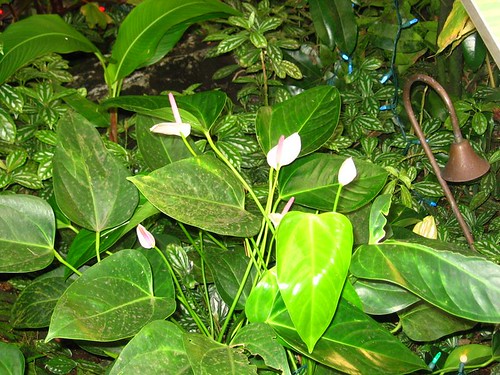 |
| Pale purple Anthurium |
They also have a number of the unique foliage species of Anthuriums, including the King Anthurium (Anthurium veitchii). Notice the size of the guard rail in comparison.
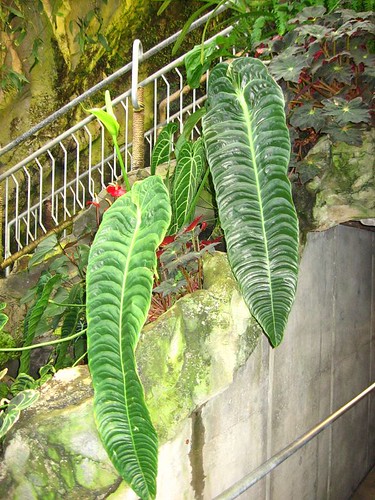 |
| King Anthurium (Anthurium veitchii) |
I also saw a cool shingler Aroid that I had never seen before. This little climber was so appressed to the rock wall that the leaves were conforming to the contours of the rocks.
 |
| Rhaphidophora cryptantha - an Aroid shingler - at the Myriad Gardens |
Really there were tons more Aroids that I noticed (and photographed) but I won't waste any more space here. If you're interested, go to
my photo album to see them.
Marantaceae (Prayer Plants)
This category was also not mentioned on the official website, but I noticed quite a few unique species from this family that I had never seen before, and several that I had. Two particular varieties from the same species caught my attention. I had seen the Stromanthe 'Triostar' before, but never this large.
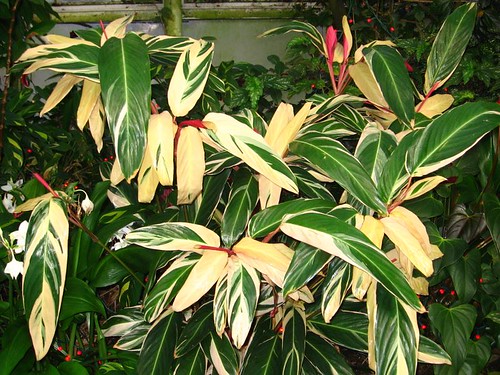 |
| Stromanthe sanguinea 'Triostar' at the Myriad Gardens |
I have not quite identified the other variety, but I think it is also from
Stromanthe sanguinea.
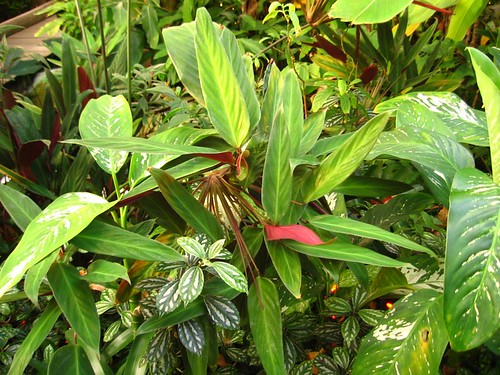 |
| Stromanthe sanguinea(?) at the Myriad Gardens |
Of course, there were also several very large Zebra Plants (
Calathea zebrina), of which I have a small one of my own at home. It was fun to see these plants waist high or higher.
Palms
According to their website, there are supposedly 100 species of palms in the Myriad Gardens. If I had to count, I would probably tell you there were about 10. The only palm I could correctly identify was the Coconut Palm (Cocos nucifera). They also have the palm species which has some of the largest leaves in the world - the Bismarckia nobilis.
 |
| One of the palms in the Myriad Gardens |
Cycads
The Myriad Gardens also has a nice collection of cycads scattered throughout their rainforest collection. Cycads are pretty much the oldest plants on the planet, having shared time with dinosaurs. They are often mistaken as palms and have similar characteristics, but are usually shorter. I don't know that I got any good pictures of the Cycads.
Gingers
Ah, one of my favorites! The collection of gingers may just seem large, but not very diverse, whenever the plants are out of bloom. But when they are in bloom, it is easier to see that the Myriad Gardens has a number of different species of Gingers. These are beautiful, tall plants with very colorful blooms. I am still waiting for my own personal shell ginger to bloom. Maybe next summer.
 |
| A variegated shell ginger - Alpinia zerumbet 'variegata' - at the Myriad Gardens |
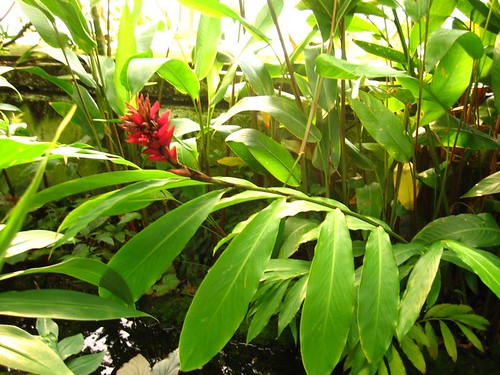 |
| An unknown ginger at the Myriad Gardens |
One closely related plant to the family of gingers is the genus Heliconia. Heliconias are commonly called "False Bird of Paradise" because of their resemblance to the Bird of Paradise inflorescence. The Myriad Gardens had a couple of different Heliconias in their collection.
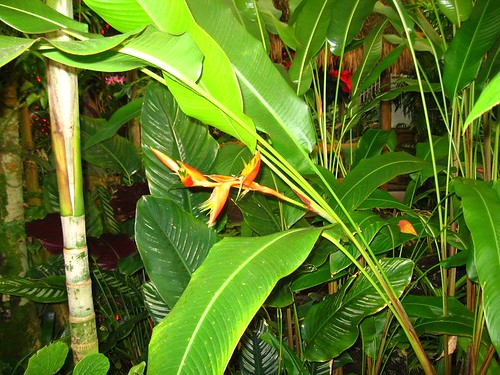 |
| False Bird of Paradise - Heliconia lankesteria |
Bromeliads
No one would call this collection of bromeliads small. And it seems they are always in bloom. The botanical family Bromeliaceae contains the genera Aechmea (the most common Bromeliad), Ananas (which includes the Pineapple plant), Billbergia, Bromelia, Cryptanthus, Tillandsia (commonly called "Air plant") and more than 50 others. Many of the Bromeliads (Aechmeas, Ananas) are planted in the ground, while others (Tillandsia) are growing attached to trees or rock. I didn't take too many pictures of the bromeliads, but there are several in
my photo album.
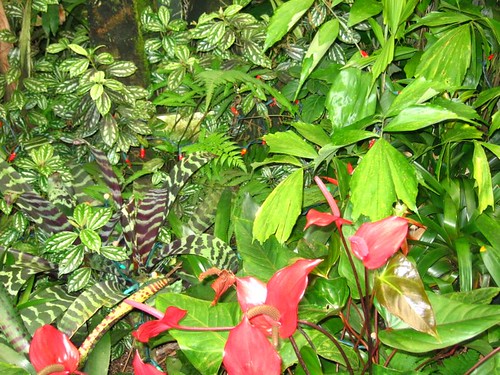 |
| One of my favorite Bromeliads on the left (striped purple and green). |
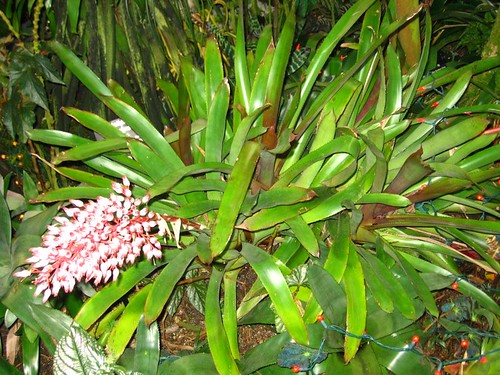 |
| One of the many bromeliads in bloom |
Orchids
The Myriad Gardens actually has a fantastic display of orchids. At one location there is a concentrated wall of orchids. But elsewhere in the rain forest collection you can see them attached to trees and rocks and walls. It is simply amazing how many orchids are in bloom at any one time. More than 1200 of the orchids in the collection were bequeathed to the Gardens in 2002 by a local collector named Fred Strothmann.
My photo album has quite a few pictures of the orchid collection. Even though I have had some experience raising orchids, I didn't try to tackle identifying any of them. I could tell a couple of the genera, but nothing beyond that.
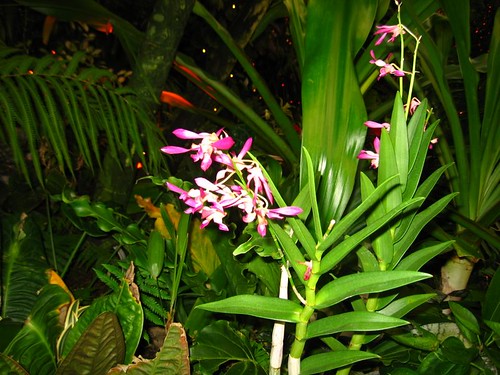 |
| Unknown Dendrobium orchid |
Begonias
To be honest, I only noticed 3 or 4 begonias in the Gardens, but the website states that there are over 100 species present. I'm not denying that they were there, because I was kind of being overstimulated by the place. If I worked there everyday it would probably take a good month before my head stopped spinning each time I walked in the Gardens. One particular (large) begonia did catch my eye, the Begonia 'Black Taffeta.'
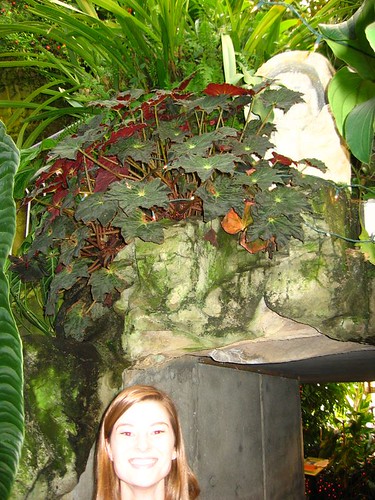 |
| Begonia 'Black Taffeta' and my beautiful wife |
Euphorbias
Euphorbias are a bit of mystery to me. Why? Well, because the most common Euphorbia I know is Euphorbia pulcherrima - The Poinsettia. Most of the other Euphorbias with which I am familiar all have spines and are what I would call in a very general sense - cacti. Now I know that technically Euphorbias are not cacti, and I'm okay with that. But what I don't understand is what is the Poinsettia doing in the same genus as Euphorbia lactea?
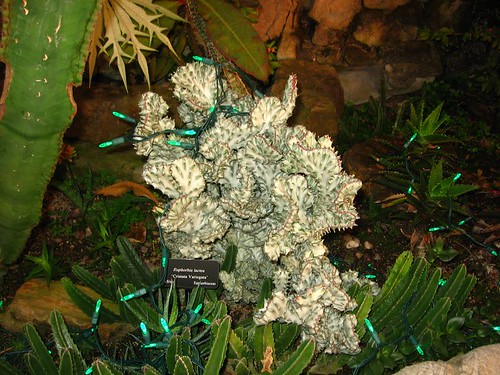 |
| Euphorbia lactea 'Cristata' |
The Myriad Gardens collection of Euphorbias resides in the dry tropical zone. Do you know the difference between a cactus and a Euphorbia? Euphorbias grow in the Eastern Hemisphere while cacti grown in the Western Hemisphere. Both plant groupings are filled with succulent plants with thick stems that store a milky sap and require very little moisture in their natural environments. The Myriad Gardens collection of Euphorbias contains 40 species and if I had to guess, I would have told you it contained more than that. There are quite a few pictures of Euphorbias in
my photo album.
My favorite Euphorbia in the building was probably
Euphorbia punicea - The Jamaican Poinsettia tree. Here is one picture and there are a couple more pictures in
my photo album.
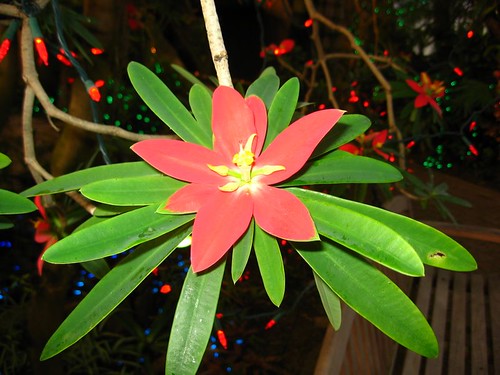 |
| Euphorbia punicea - The Jamaican Poinsettia Tree |
The Myriad Gardens are a really great place to visit, with a small admission for the time that you can spend inside (if you're a plant lover). If you haven't yet clicked on any of the dozens of links I provided to
my photo album, I suggest you do so now. You can get a better feel for the wonderful collection on hand.















Wonderful Wonderful photos!
ReplyDeleteI am going to try to make it up there before next Christmas! A great attraction!